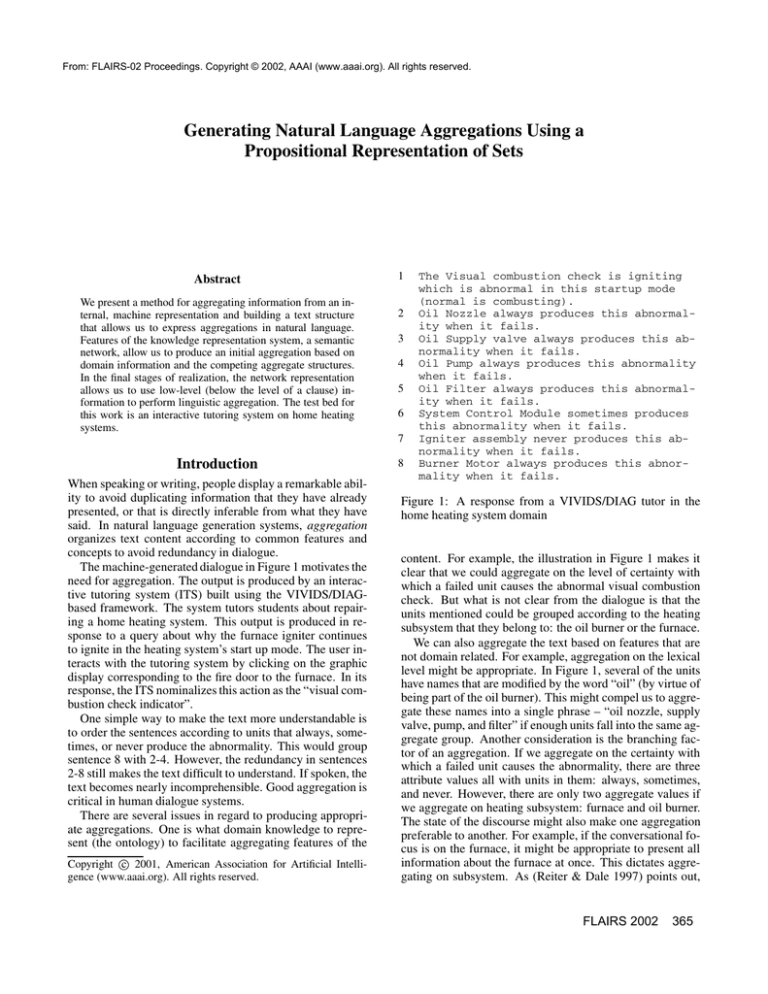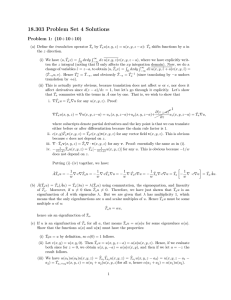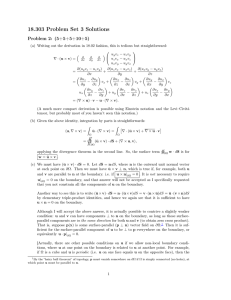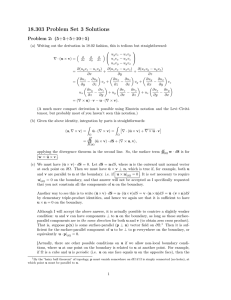
From: FLAIRS-02 Proceedings. Copyright © 2002, AAAI (www.aaai.org). All rights reserved.
Generating Natural Language Aggregations Using a
Propositional Representation of Sets
Abstract
We present a method for aggregating information from an internal, machine representation and building a text structure
that allows us to express aggregations in natural language.
Features of the knowledge representation system, a semantic
network, allow us to produce an initial aggregation based on
domain information and the competing aggregate structures.
In the final stages of realization, the network representation
allows us to use low-level (below the level of a clause) information to perform linguistic aggregation. The test bed for
this work is an interactive tutoring system on home heating
systems.
1
2
3
4
5
6
7
Introduction
When speaking or writing, people display a remarkable ability to avoid duplicating information that they have already
presented, or that is directly inferable from what they have
said. In natural language generation systems, aggregation
organizes text content according to common features and
concepts to avoid redundancy in dialogue.
The machine-generated dialogue in Figure 1 motivates the
need for aggregation. The output is produced by an interactive tutoring system (ITS) built using the VIVIDS/DIAGbased framework. The system tutors students about repairing a home heating system. This output is produced in response to a query about why the furnace igniter continues
to ignite in the heating system’s start up mode. The user interacts with the tutoring system by clicking on the graphic
display corresponding to the fire door to the furnace. In its
response, the ITS nominalizes this action as the “visual combustion check indicator”.
One simple way to make the text more understandable is
to order the sentences according to units that always, sometimes, or never produce the abnormality. This would group
sentence 8 with 2-4. However, the redundancy in sentences
2-8 still makes the text difficult to understand. If spoken, the
text becomes nearly incomprehensible. Good aggregation is
critical in human dialogue systems.
There are several issues in regard to producing appropriate aggregations. One is what domain knowledge to represent (the ontology) to facilitate aggregating features of the
­
Copyright c 2001, American Association for Artificial Intelligence (www.aaai.org). All rights reserved.
8
The Visual combustion check is igniting
which is abnormal in this startup mode
(normal is combusting).
Oil Nozzle always produces this abnormality when it fails.
Oil Supply valve always produces this abnormality when it fails.
Oil Pump always produces this abnormality
when it fails.
Oil Filter always produces this abnormality when it fails.
System Control Module sometimes produces
this abnormality when it fails.
Igniter assembly never produces this abnormality when it fails.
Burner Motor always produces this abnormality when it fails.
Figure 1: A response from a VIVIDS/DIAG tutor in the
home heating system domain
content. For example, the illustration in Figure 1 makes it
clear that we could aggregate on the level of certainty with
which a failed unit causes the abnormal visual combustion
check. But what is not clear from the dialogue is that the
units mentioned could be grouped according to the heating
subsystem that they belong to: the oil burner or the furnace.
We can also aggregate the text based on features that are
not domain related. For example, aggregation on the lexical
level might be appropriate. In Figure 1, several of the units
have names that are modified by the word “oil” (by virtue of
being part of the oil burner). This might compel us to aggregate these names into a single phrase – “oil nozzle, supply
valve, pump, and filter” if enough units fall into the same aggregate group. Another consideration is the branching factor of an aggregation. If we aggregate on the certainty with
which a failed unit causes the abnormality, there are three
attribute values all with units in them: always, sometimes,
and never. However, there are only two aggregate values if
we aggregate on heating subsystem: furnace and oil burner.
The state of the discourse might also make one aggregation
preferable to another. For example, if the conversational focus is on the furnace, it might be appropriate to present all
information about the furnace at once. This dictates aggregating on subsystem. As (Reiter & Dale 1997) points out,
FLAIRS 2002
365
m42!
TextStructurer
CQ
CT
ME
NA
OBJECT
OB
JE
CT
ER
OP
PR
inoperative
m40
startup
igniting
LEX
oil−nozzle
b10
LEX
m38
TY
TY
m41
ER
ER
LEX
LEX
text response
OP
LEX
b2
PR
MODE
SNePS
OBJECT
m39
CERTAINTY
SurfaceGenerator
GEN
OP
Java API
m34!
TES
ERA
m4 !
PR
T
AN
JE
Client
OB
VIVIDS/DIAG
always
Figure 2: System Configuration
one of the most difficult problems with aggregation is deciding on which among the numerous potential (and possibly
conflicting) aggregations to perform.
In the next section, we describe the relevant architecture
of our system and pertinent features of the the knowledge
representation system and generation tool that we have integrated. Then, we work through the example above to show
what our system produces and why. We conclude with a
discussion of our work to date and future work.
System Overview
DIAG is a shell to build ITSs that teach students to trouble shoot systems such as home heating and circuitry(Towne
1997a; 1997b). DIAG builds on the VIVIDS authoring environment, a tool for building interactive graphical models
of complex systems(Munro 1994). A typical session with a
DIAG application presents the student with a series of troubleshooting problems of increasing difficulty. At any point,
the student can consult the built-in tutor in one of several
ways. For example, if the student is unsure what the reported
status of a system indicator means, she can consult the tutor
about it. Figure 1 is an example of the original DIAG system’s output in a case like this. After selecting content, the
original DIAG uses simple templates to assemble the text to
present to the student. The result is that DIAG’s feedback is
repetitive. Furthermore, this problem is compounded by the
fact that DIAG applications involve complex domains with
many parts that DIAG might need to report on in a single
response
Figure 2 shows the basic configuration of subsystems that
we use to interface to a VIVIDS/DIAG tutor. Solid lines
indicate control flow, and dashed lines indicate communication and data flow. A Java Client establishes a TCP/IP
connection to the VIVIDS/DIAG tutor, listens to the tutor,
and intercepts the content of each tutor response. The tutor’s representation of the content is impoverished, so the
Client interfaces to the Semantic Knowledge Representation and Reasoning System (SNePS) to represent the content
of the tutor’s response in a semantic network.
SNePS is a semantic network knowledge representation
and reasoning system with a logic that targets natural language understanding and commonsense reasoning(Shapiro
2000). A SNePS network is said to be propositional, because all propositions in the network are represented by
nodes. In SNePS, there are nodes and labeled, directed
366
FLAIRS 2002
Figure 3: SNePS Network for: If m39 b2 is inoperative,
then m41 m39 causes m34! (b10 igniting in startup mode)
with certainty always
edges called arcs. All nodes represent concepts, either objects or propositional concepts. When information is added
to the network, it is added as a node with arcs emanating
from it to other nodes. A SNePS feature that aids linguistic aggregation is that each concept in the network is represented by a unique node. This is called the Uniqueness
Principle.
Figure 3 shows an example of SNePS network that is
constructed to make part of the response in our example.
SNePS-2.5 uses an assertion flag (represented with a !) to
distinguish what is asserted as true from other propositions.
m42! is a rule that asserts that if m39 (ANT = antecedent)
then m41 (CQ = consequent). m39 is the proposition that
object b2 is inoperative, and m41 is the proposition that the
situation represented by m39 always causes m34!. m34!
asserts that object b10 is igniting in startup mode. In summary, m42! asserts that if b2 is inoperative, then its failure always causes b10 to ignite in startup mode. Another
network segment m4! asserts that b2 is called a oilnozzle. While m4!, m42! and m34! are asserted as
true, propositions m39 and 41 are not asserted, indicating
that they are not known to be true. The semantic network is
loaded apriori with static information about the home heating system, for example, that the oil-nozzle is a component of the oil burner. Then transitory information (information for the specific response like Figure 3) is added by
the Client.
The Client invokes a Java TextStructurer to build
a text structure of rhetorical relations based on Rhetorical
Structure Theory (RST) (Mann & Thompson 1988). Each
rhetorical relation has at least one nucleus, the core idea to
be communicated. A nucleus can be augmented with a satellite, a clause that is related to the nucleus but is not required.
According to RST, the communication of the satellite in addition to the nucleus also communicates to the listener the
relationship between the satellite and the nucleus. Figure
4 shows a rhetorical relation built from the SNePS network
in Figure3. The nucleus is at the arrow head, m41, and the
satellite is m39. The arrow going from m39 to m41 indicates that, as a satellite, m39 is a condition for m41. The
TextStructurer queries the SNePS network to build
the text structure starting with a nucleus, in this case m41.
(a)
CONDITION
m20!
sometimes
m39
m41
never
m15!
The actual query looks for a ANT-CQ arc relationship between an unasserted node in the network and nucleus m41.
Node m42! expresses this relationship, and m39 is added to
the text structure as a satellite in a CONDITION rhetorical
relationship. When this text structure is traversed by the surface generator, it can be used to determine a linear ordering
of the information in these nodes and to add cue phrases to
the text. For example, Figure 4 could be realized as “if m39
then m41” or “m41 whenever m39”.
The TextStructurer makes repeated queries until no
new text structure can be built. Then the TextStructurer invokes the SurfaceGenerator to realize the
complete text structure in natural language. Since the nuclei and satellites in the text structure are SNePS nodes, the
SurfaceGenerator also queries the network to build a
linearization. The TextStructurer and the SurfaceGenerator are written using Exemplars, a object-oriented
framework for building generation grammars that allow for
mixing template-style processing with more sophisticated
text planning (White & Caldwell 1998).
An Example
When the user asks the VIVIDS/DIAG tutor about the visual combustion check indicator, the Client receives a set
of records. The initial record shows that the user wishes
to consult the tutor about a heating system indicator, the
visual combustion check indicator. The records that follow are about units that could be replaced (called “replaceable units” or RUs) and the certainty with which each RU
causes the abnormal indication. After adding the information to the SNePS network, the Client invokes the
TextStructurer with the values "ConsultIndicator" and "visual combustion check".
The Client does not pass the TextStructurer any
content for the response. The TextStructurer is passed
the task to perform: building a response that consults the
user on the visual combustion check indicator. As discussed,
different aggregation issues become important at different
always
m62! m51! m48! m45! m42!
(b)
sometimes
Given a nucleus,
if there is a node in the network that is
NOT asserted and that
is an antecedent to the nucleus
then
the node is a satellite to the nucleus
in the CONDITION relationship
never
m59!
m55!
Figure 4: Text structure built using m39 and m41 in Figure
3
In this example, the TextStructurer applies a rule that
states that:
sometimes
always
m20!
m55!
m15!
never
m20!
m15!
always
m20!
m15!
m59!
m62! m51! m48! m45! m42!
Figure 5: (a): Aggregation by system then certainty and
(b): Aggregation by certainty then system
stages of building the text structure. Therefore, we let the
TextStructurer select content as it builds and refines
the text structure.
At the first stage, TextStructurer queries the SNePS
network for the initial state of the visual combustion check
indicator and all assertions in the network about what could
contribute to this state. This results in a query that returns
nodes like m42! in Figure 3. We will refer to this node
set as a certainty statements. At this point in our work, the
TextStructurer always aggregates certainty statements
on two dimensions:1 (1) the subsystem heating system that
each RU belongs to and 2) the certainty with which an RU
failure can cause the indicator abnormality. We refer to these
as the system and certainty aggregation dimensions. The
TextStructurer aggregates the certainty statements on
(a) system, and within each system, on certainty. It also
aggregates them on (b) certainty, and within each level of
certainty, by system. Figure 5 shows the two Aggregation objects. Currently, we select the aggregation with the
smaller initial branching factor. Since the system dimension
has only two values, the TextStructurer selects aggregation (a) Figure in 5 to use as the initial nuclear content of
the text structure.
Next, the Aggregation structure is mapped to appropriate rhetorical relations to make a text structure. The first
aggregation dimension is by system, and it has two values:
asserted nodes m20! and m15!. Space does not permit
showing these nodes. However, m20! asserts that the RU
mentioned in certainty statement m55! is a component of
the furnace system, and m15! asserts that all the RUs mentioned in certainty statements m59!, m62!, m51!, m48!,
m45!, and m42! are components of the oil burner. This
division is based on an arbitrary (from a language point
of view) division of the heating system into units. Therefore, no rhetorical relationship exists between m20! and
1
However, we are not limited to two dimensions. We can aggregate over any number of dimensions.
FLAIRS 2002
367
JOINT:
JOINT: m20!
NVRESULT
JOINT: m15!
ELABORATION
JOINT
JOINT: always
m55!
m36!
m59!
m34!
m20!
...
m15!
Figure 7: The text structure with satellites added
m62! m51! m48! m45! m42!
JOINT:
Figure 6: The text structure built from the initial aggregation
JOINT: m20!
m15! and they are mapped to the only non-relation in RST:
JOINT.
The nodes in the sub-aggregation under m15! are aggregated by scalar values “always”, “sometimes”, and “never”.
At this point in our work, this aggregation is also realized
with a JOINT. The TextStructurer builds the initial
text structure shown in Figure 6. Notice that most of the
JOINT relations are coupled with a node, for example,
JOINT: m15!
Node m15! is an assertion about a set of arguments. Each
argument in the set is also an argument in each of the assertions represented by nodes m59!, m62!, m51!, m48!,
m45! and m42!. m15! holds over this set of arguments
and is the basis of this JOINT. Namely, m15! asserts that an
argument from each of the latter group of nodes is a unit of
the oil burner assembly.
The top-level JOINT is not coupled with an assertion.
This JOINT represents the initial aggregation, based on no
represented knowledge, and only the branching factor of the
aggregation. The only effect that the top-level JOINT relation will have is to make sure that the information at node
m55! and the information under the JOINT labelled m15!
are parallel text structures. Similarly, the JOINT labelled
with m15! ensures that parallel text structures will be used
for the content of node m59! and the third-tier JOINT labelled with a network base node, always. Since this node
is not an assertion (or least a propositional node), there is
no way to express what the five certainty statements have
in common in this JOINT, namely, that these are all assertions about units that always cause the abnormality being
discussed.
Expanding the Structure
The TextStructurer expands the text structure in 6
with satellites. Figure 7 shows this expansion. In our example the top-level, multi-nuclear JOINT is augmented using a
non-volitional result relation (NVRESULT) to add the satellite m34!. This will, in turn be augmented with m36! as a
satellite using an ELABORATION relation.
CONDITION
CONDITION
m52
m56
m54
m58
JOINT: m15!
JOINT: always
CONDITION
m39 m49 m46 m43 m60
m41 m50 m47 m44 m61
Figure 8: Figure 6 after structuring within
clauses that are about other clauses. The SNePs logic is not
strictly first-order. SNePS nodes can and often do represent propositions about propositions. Since we want to be
able to aggregate over any all content arbitrarily, we must be
able to structure content that is already part of an overarching text structure. As an example of structuring within, we
use node m42! in Figure 3. Structuring within will replace
m42! with a text structure in which the antecedent of m42!
(node m39) becomes the satellite to the consequent of m42!
(node m41) in a CONDITION rhetorical relation. The new
text structure is given in Figure 4. All the nodes representing certainty statements can be similarly structured within
replacing each with a CONDITION rhetorical relation. This
results in Figure 6 being replaced with the Figure 8.
If the text structure in Figures 7 and 8 were realized using
only templates, the output would be
1
2
3
4
5
6
7
8
A visual combustion check indicator is
igniting in startup mode.
The visual combustion check indicator igniting in startup mode is abnormal.
Within the furnace system, this is sometimes caused
when the system control module is inoperative.
Within the oil burner, this is never caused when
an igniter-assembly replaceable-unit is
inoperative.
This is always caused when a burner motor
is inoperative.
This is always caused when an oil filter
replaceable unit is inoperative.
This is always caused when an oil pump
replaceable unit is inoperative.
This is always caused when an oil supply
valve replaceable unit is inoperative.
This is always caused when an oil nozzle
replaceable unit is inoperative.
Structuring Within
9
The TextStructurer uses a second process to structure
text that we call structuring within. Structuring within becomes necessary because the initial aggregation can contain
The italicized phrases are the contribution of the assertions represented by nodes m20! and m15!. The repeated
368
FLAIRS 2002
Discussion and Future Work
m42!
CQ
T
OB
JE
CT
ER
m38
m40
LEX
ER
OB
P
RO
inoperative
igniting
CT
startup
LEX
TY
b6
b10
LEX
TY
LEX
CERTAINTY
OP
JE
m41
PR
OB
GEN
OBJECT
m39
b2
m34!
S
TE
ERA
TY
ER
OP
PR
MODE
AN
S
TE
always
CT
JE
P
T
CERTAINTY
GE
CQ
m61
AN
RA
NE
OBJECT
m60
m62!
Figure 9: Structures shared in certainty statements m42!
and m62!
use of “this” is a reference to node m34! which represents
the visual combustion check indicator igniting in startup
mode.
Exploiting Structure Sharing
Domain-level information (as represented by propositions)
cannot address the redundancy when the third-tier JOINT
(lines 5–9) is realized. At this point, the basis for aggregation is below the clause level. This problem exists at some
point in any ontology that is used,
We address it by exploiting the set logic of SNePS to perform aggregations on the basis of shared network structure
at representational level below the clause. Figure 9 shows
two of the five certainty statements in the original third-tier
JOINT (nodes m42! and m62!) and the antecedent and
consequent of each of them (nodes m39, m41, m60, and
m61 – shaded). The two antecedents m39 and m60 share
node m38 in the same relationship (as a property). This node
represents the lexicalization of “inoperative”. The two consequents m41 and m61 share node m40 and m34! in the
same relationships, as a certainty and a generated cause respectively. m40 represents the lexicalization of “always”.
All the antecedents in Figure ?? share m38, and all the consequents share m34! and m40.
During surface realization, network queries return shared
nodes when all the antecedent nodes are used as a set
argument in the query. Nodes like m38 are returned.
Similarly, we query the network for information about
the set of consequents and return m40 and m34!. Shares
structures are realized once. Hence m34!, one of the two
nodes shared by the consequents in the generates relation is
expressed as “this is .... caused”. Together with the other
shared node, m40, the consequents are collectively realized
as “this is always caused”. Similarly, the node shared
among the antecedents, m38, is expressed once as “... is
inoperative”. Since the unit names do not share structure,
they are enumerated. As a result of structure sharing, we
generate the the following aggregation in place of lines 5-9
above.
5
Semantic networks have capabilities similar to a relational
database. In addition, they have great representational
power. We have exploited these features to generate aggregations in natural language. As our example illustrates,
the network allows us to aggregate based on domain information, for example, system and certainty. We can
also aggregate based on domain-independent features. The
antecedent-consequent relation is an example of this. Furthermore, during surface realization, shared structure is used
to aggregate the text below the clause level.
In future work, we will investigate how to automatically
determine aggregation dimensions from a set of nodes that
are to be aggregated. We will also consider the state of the
discourse in choosing and ordering aggregation dimensions.
References
Mann, W. C., and Thompson, S. A. 1988. Rhetorical structure theory: Towards a functional theory of text organization. TEXT 8(3):243–281.
Munro, A. 1994. Authoring interactive graphical models.
In Jong, T.; Towne, D. M.; and Spada, H., eds., The Use of
Computer Models for Explication, Analysis, and Experiential Learning. Springer Verlag.
Reiter, E., and Dale, R. 1997. Building applied natural language generation systems. Natural Language Engineering
3.
Shapiro, S. C. 2000. SNePS: A logic for natural language
understanding and commonsense reasoning. In Iwanska,
L. M., and Shapiro, S. C., eds., Natural Language Processing and Knowledge Representation. AAAI Press/MIT
Press.
Towne, D. M. 1997a. Approximate reasoning techniques
for intelligent diagnostic instruction. International Journal
of Artificial Intelligence in Education.
Towne, D. M. 1997b. Intelligent diagnostic tutoring using
qualitative symptom information. In AAAI Fall Symposium
on ITS Authoring Tools.
White, M., and Caldwell, T. 1998. Exemplars: A practical,
extensible framework for dynamic text generation. In Proceedings of the Ninth International Workshop on Natural
Language Generation.
This is always caused when a burner
motor, oil filter, oil pump, oil supply valve, or oil nozzle replaceable
unit is inoperative.
FLAIRS 2002
369





